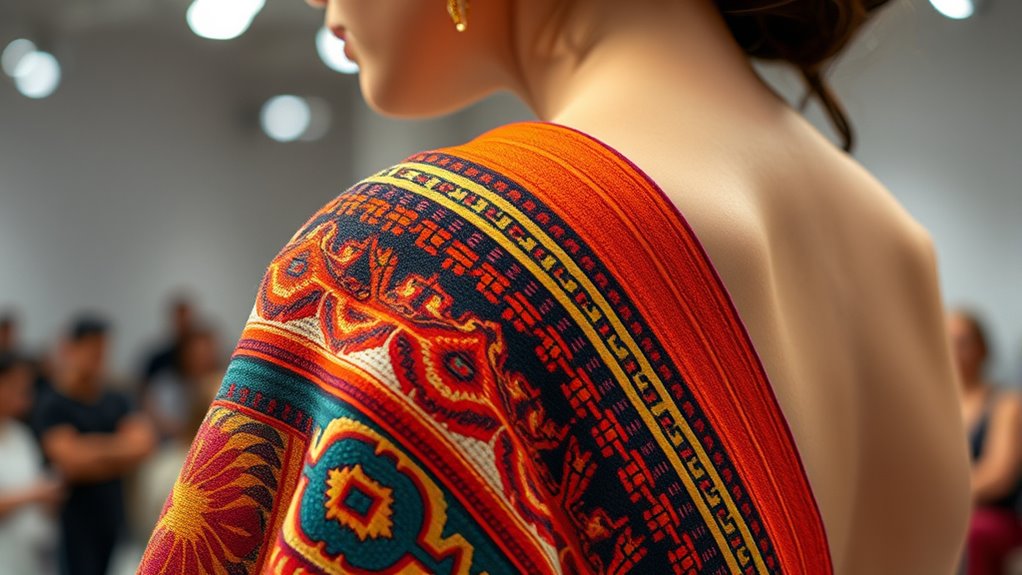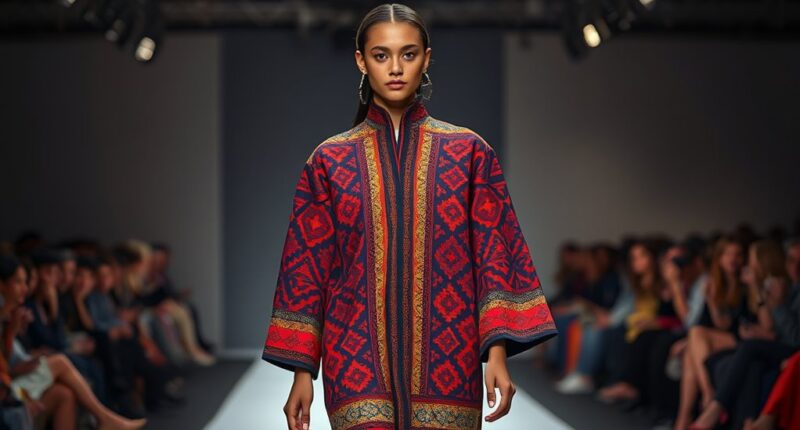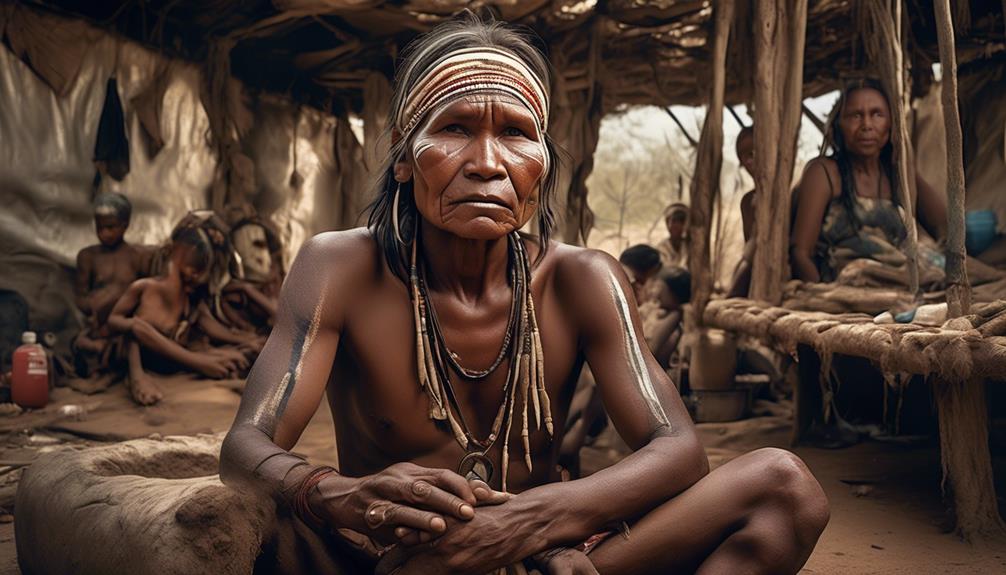When using Indigenous designs in fashion, it’s essential to respect their cultural significance by seeking permission, giving proper credit, and collaborating with Indigenous communities. Avoid cultural appropriation by understanding the history behind the motifs and ensuring you’re not exploiting or misrepresenting their culture. Legal rights also matter—proper licensing and acknowledgment help protect Indigenous intellectual property. If you continue exploring, you’ll discover ways to honor these designs ethically and thoughtfully.
Key Takeaways
- Respect indigenous cultural ownership by seeking permission and providing proper acknowledgment when using traditional designs.
- Avoid cultural appropriation by understanding and honoring the cultural significance of Indigenous motifs.
- Engage in fair collaboration and offer compensation to Indigenous communities involved in design partnerships.
- Comply with legal protections and intellectual property rights to prevent exploitation and unauthorized use.
- Promote responsible use by fostering open dialogue, cultural sensitivity, and supporting Indigenous artisans and their heritage.

Have you ever considered the ethical implications of using Indigenous designs in fashion, art, or commercial products? When you incorporate these designs without proper acknowledgment or permission, you’re stepping into complex territory that involves cultural appropriation and issues surrounding intellectual property. Cultural appropriation occurs when someone takes elements of an Indigenous culture—like patterns, symbols, or traditional motifs—and uses them outside their original context, often without understanding or respecting their significance. This can lead to misrepresentation, commodification, and even disrespect toward the communities involved. As a creator or consumer, you need to recognize that these designs are not just decorative; they carry deep cultural meaning and history. Using them without permission can perpetuate stereotypes or diminish the community’s cultural sovereignty.
From a legal standpoint, respecting intellectual property rights is essential. Many Indigenous communities view their traditional knowledge and designs as protected cultural expressions, which should not be exploited for profit without proper licensing or acknowledgment. While intellectual property laws vary across countries, the core principle is that creators should have control over how their work is used. When you use Indigenous designs without engaging with the community or securing rights, you’re risking legal repercussions and contributing to the ongoing marginalization of those communities. It’s important to ask yourself whether your use of these designs is an act of appreciation or appropriation. Genuine respect involves collaboration, fair compensation, and giving credit where it’s due, rather than simply borrowing for aesthetic appeal.
Respect Indigenous intellectual property by seeking permission, collaborating, and giving credit to honor their cultural expressions.
Furthermore, you should consider the broader impact of your choices in fashion or product development. By prioritizing ethical sourcing and respecting cultural ownership, you promote diversity and support Indigenous communities’ rights to their traditional knowledge. When you choose to incorporate Indigenous designs responsibly, you contribute to elevating their cultural expressions rather than exploiting them. Engaging in open dialogue with community members, seeking permission, and partnering with Indigenous artisans can transform what might have been an act of cultural insensitivity into a meaningful exchange. Additionally, understanding that cultural sensitivity is crucial in avoiding harmful stereotypes helps foster more respectful interactions.
Remember, respecting intellectual property rights isn’t just about legality; it’s about honoring the people behind the designs and acknowledging their cultural sovereignty. In doing so, you also help preserve the integrity and authenticity of Indigenous art forms for future generations.
Frequently Asked Questions
How Can Brands Ensure Respectful Collaboration With Indigenous Communities?
To guarantee respectful collaboration with indigenous communities, you should prioritize cultural sensitivity and genuine community engagement. Listen carefully to their perspectives, involve them in decision-making, and respect their traditions and intellectual property. By building trust and establishing transparent partnerships, you demonstrate your commitment to ethical practices. Always seek permission before using their designs and share benefits fairly, fostering a respectful, mutually beneficial relationship.
What Legal Protections Exist for Indigenous Designs in Fashion?
You should know that legal protections for indigenous designs mainly involve intellectual property laws like trademarks, copyrights, and patents, which help safeguard unique patterns and symbols. Additionally, cultural safeguarding initiatives aim to protect indigenous knowledge and heritage from misappropriation. While these protections vary by country, they’re essential for ensuring that indigenous communities retain control over their designs and cultural expressions, encouraging respectful collaboration and preventing exploitation in fashion.
How Do Cultural Differences Influence Perceptions of Design Appropriation?
You see that cultural differences shape how people perceive design appropriation, emphasizing the need for cultural sensitivity. In some cultures, borrowing designs may be seen as respectful admiration, while others view it as disrespectful or exploitative. You should prioritize understanding and respecting each culture’s view on artistic authenticity, ensuring your work honors their traditions. This approach fosters genuine appreciation and avoids misinterpretation or offense.
Are There Examples of Successful Ethical Partnerships in Fashion?
You’ll find that successful ethical partnerships in fashion often center on cultural appreciation and fair trade practices. Brands collaborate directly with indigenous communities, ensuring respectful representation and equitable compensation. For example, some companies partner with artisans to create authentic, culturally meaningful designs, benefiting both parties. These collaborations foster trust and sustainability, demonstrating how ethical practices can drive creative innovation while honoring cultural heritage.
What Role Do Consumers Play in Promoting Ethical Use of Indigenous Designs?
You play a essential role in promoting ethical use of indigenous designs through your consumer influence and ethical awareness. When you choose to support brands that respect and collaborate with indigenous communities, you send a powerful message. Your purchasing decisions can encourage companies to prioritize fair practices and cultural integrity. By staying informed and advocating for ethical standards, you help create a fashion industry that values indigenous rights and fosters respectful partnerships.
Conclusion
Imagine your favorite garden, full of vibrant, unique flowers. If you pick a bloom without knowing its story or giving thanks to the gardener, you risk ruining the beauty for everyone else. Similarly, when you use indigenous designs without understanding or respecting their origins, you threaten the richness and diversity of that cultural garden. To truly honor it, walk gently, learn its story, and share its beauty responsibly. That’s how true respect blossoms.









